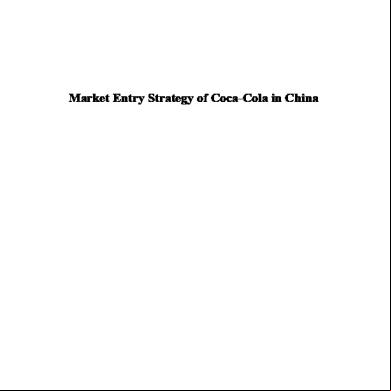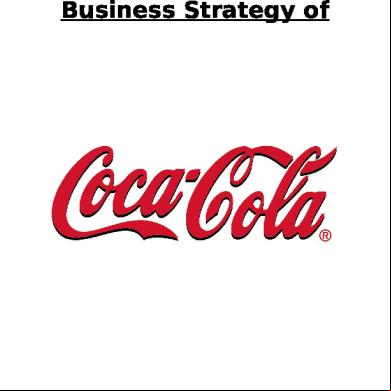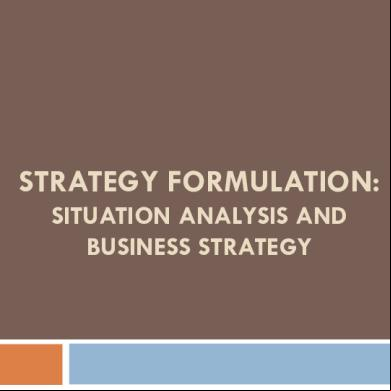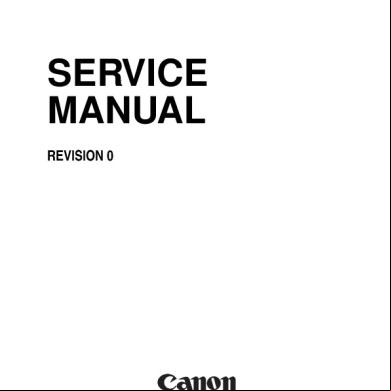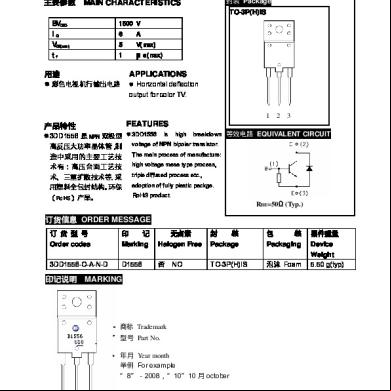Coca Cola Strategy Formulation 473k6a
This document was ed by and they confirmed that they have the permission to share it. If you are author or own the copyright of this book, please report to us by using this report form. Report 2z6p3t
Overview 5o1f4z
& View Coca Cola Strategy Formulation as PDF for free.
More details 6z3438
- Words: 605
- Pages: 60
Type
Soft Drink (Cola)
Manufacturer
The Coca- Cola Company
Founder (s)
John S. Pemberton
Country of Origin
United States
Introduced
1886
Area Served
Over 200 countries Cola, Cola Green Tea, Cola Lemon, Cola Lemon Lime, Cola Lime, Cola Orange and
Flavors
Cola Raspberry.
Employees Servings per Day
92,400 1.6 Billion
1•
2•
3•
4•
Coca-Cola was first sold to the public in Atlanta at Jacob’s Pharmacy Only 9 servings of the soft drink were sold each day Sales for the first year were only $50 Today it has 3000 brands-200 nations
VISION
VISION
MISSION To refresh the world in body, mind and spirit 2• To inspire moments of optimism through our brands and our actions 3• To create value and make a difference everywhere we engage. 1•
VALUES 1• 2• 3• 4• 5• 6•
Leadership: The courage to shape a better future Collaboration: Leverage collective genius Integrity: Be real ability: If it is to be, it's up to me ion: Committed in heart and mind Diversity: As inclusive as our brands
7•
Quality: What we do, we do well
Coca-Cola Bottles 1894 was the first time Coca-Cola was bottled 1894- early 1900s
1905-1916
1915- today
EXTERNAL ENVIRONMENT
ENVIRONMENTAL ANALYSIS
PO LITI CA L AN AL YSI S EC ON OM IC ANALYSIS
LEGAL ANALY SIS
TECHN OLOGY ANLYSIS
INDUSTRY ANALYSIS 1•
2•
3•
The food and beverage industry encomes harvesting, processing, milling, packaging, transport and distribution of products to consumers. In 1999, the value of food and beverage industry shipments reached an estimated $487 billion. The needs that customer might be seeking to satisfy are: 1∙ Physiological: the need of special food items 2∙ Economic: the need for good value for the price paid 3∙ Social: a friendly atmosphere, to express feelings frankly 4∙ Psychological: the need for enhancement of self‐ esteem 5∙ Convenience: the desire for someone else to do the
work.
PORTER’ s FIVE FORCEs MODEL Potential entrants Threat of new entrants
Bargaining power of suppliers
Industry competitors
Supplier s
Buyers Rivalry among existing firms Threat of
Bargaining power of buyers
substitute s
Substitute products
COMPANY ANALYSIS REVENUE years
20 11
20 10
20 09
20 08
20 07
Revenue
46.54B 35.12B 30.99B 31.94B 28.86B
Gross profit operating income
28.33B 22.43B 19.90B 20.57B 18.54B
Net income
8.572B 11.81B 6.824B 5.807B 5.981B
10.15B 8.499B 8.231B 8.446B 7.252B
coca cola
pepsi.co
othe rs
5%
35% 60%
Product Portfolio of CCI
others 15% kinle y 11% sprite 10%
coca cola 17%
STRATEGIES 1•
2•
3•
4•
5•
6•
Differentiated Marketing Customer satisfaction Endorsement of celebrities Reasonably priced Consumer connecting ments Availability in every local market
Future plans 1•
2•
3•
Increasing the per capita consumption of its beverages Expanding its distribution networks Leading the beverage revolution in India
COMPETITO RS
Competitors Analysis 1• 2•
3•
4•
5•
Competitors: PepsiCo, Parle Agro Products Pepsi gives tough fight with almost similar investment, ment, Strategies and Products Parle resurges with refreshing drinks as Appy Fizz, Fruity, LMN PepsiCo also has a snack product line including Lays, Cheetos and Quaker OAT’s PepsiCo provide carbonated drinks, Fruit Drinks and Packaged Drinking Water.
Comparison of financial highlights COMPANY NAME
Profit Margin Asset Turnover Return on Assets Earning Per Share
Coca cola
Pepsi.co
33.768046
10.958194
0.577
1.071
19.506218
11.736928
5.12
3.97
Comparison b/w Coke vs. Pepsi slice 20%
cola pep si 45 %
35%
mazza 80%
thum sup 20% mirinda 25%
fanta 75%
lemon mirinda 20%
limc a 80 %
everve ss 50%
kinle y 50%
7up
25%
y 80% sp rit e 7 5 %
Aquafina 20%
kin el
Questio n
Mark HIGH
LOW
STA R
CAS H CO W
DO G
Soft Drink (Cola)
Manufacturer
The Coca- Cola Company
Founder (s)
John S. Pemberton
Country of Origin
United States
Introduced
1886
Area Served
Over 200 countries Cola, Cola Green Tea, Cola Lemon, Cola Lemon Lime, Cola Lime, Cola Orange and
Flavors
Cola Raspberry.
Employees Servings per Day
92,400 1.6 Billion
1•
2•
3•
4•
Coca-Cola was first sold to the public in Atlanta at Jacob’s Pharmacy Only 9 servings of the soft drink were sold each day Sales for the first year were only $50 Today it has 3000 brands-200 nations
VISION
VISION
MISSION To refresh the world in body, mind and spirit 2• To inspire moments of optimism through our brands and our actions 3• To create value and make a difference everywhere we engage. 1•
VALUES 1• 2• 3• 4• 5• 6•
Leadership: The courage to shape a better future Collaboration: Leverage collective genius Integrity: Be real ability: If it is to be, it's up to me ion: Committed in heart and mind Diversity: As inclusive as our brands
7•
Quality: What we do, we do well
Coca-Cola Bottles 1894 was the first time Coca-Cola was bottled 1894- early 1900s
1905-1916
1915- today
EXTERNAL ENVIRONMENT
ENVIRONMENTAL ANALYSIS
PO LITI CA L AN AL YSI S EC ON OM IC ANALYSIS
LEGAL ANALY SIS
TECHN OLOGY ANLYSIS
INDUSTRY ANALYSIS 1•
2•
3•
The food and beverage industry encomes harvesting, processing, milling, packaging, transport and distribution of products to consumers. In 1999, the value of food and beverage industry shipments reached an estimated $487 billion. The needs that customer might be seeking to satisfy are: 1∙ Physiological: the need of special food items 2∙ Economic: the need for good value for the price paid 3∙ Social: a friendly atmosphere, to express feelings frankly 4∙ Psychological: the need for enhancement of self‐ esteem 5∙ Convenience: the desire for someone else to do the
work.
PORTER’ s FIVE FORCEs MODEL Potential entrants Threat of new entrants
Bargaining power of suppliers
Industry competitors
Supplier s
Buyers Rivalry among existing firms Threat of
Bargaining power of buyers
substitute s
Substitute products
COMPANY ANALYSIS REVENUE years
20 11
20 10
20 09
20 08
20 07
Revenue
46.54B 35.12B 30.99B 31.94B 28.86B
Gross profit operating income
28.33B 22.43B 19.90B 20.57B 18.54B
Net income
8.572B 11.81B 6.824B 5.807B 5.981B
10.15B 8.499B 8.231B 8.446B 7.252B
coca cola
pepsi.co
othe rs
5%
35% 60%
Product Portfolio of CCI
others 15% kinle y 11% sprite 10%
coca cola 17%
STRATEGIES 1•
2•
3•
4•
5•
6•
Differentiated Marketing Customer satisfaction Endorsement of celebrities Reasonably priced Consumer connecting ments Availability in every local market
Future plans 1•
2•
3•
Increasing the per capita consumption of its beverages Expanding its distribution networks Leading the beverage revolution in India
COMPETITO RS
Competitors Analysis 1• 2•
3•
4•
5•
Competitors: PepsiCo, Parle Agro Products Pepsi gives tough fight with almost similar investment, ment, Strategies and Products Parle resurges with refreshing drinks as Appy Fizz, Fruity, LMN PepsiCo also has a snack product line including Lays, Cheetos and Quaker OAT’s PepsiCo provide carbonated drinks, Fruit Drinks and Packaged Drinking Water.
Comparison of financial highlights COMPANY NAME
Profit Margin Asset Turnover Return on Assets Earning Per Share
Coca cola
Pepsi.co
33.768046
10.958194
0.577
1.071
19.506218
11.736928
5.12
3.97
Comparison b/w Coke vs. Pepsi slice 20%
cola pep si 45 %
35%
mazza 80%
thum sup 20% mirinda 25%
fanta 75%
lemon mirinda 20%
limc a 80 %
everve ss 50%
kinle y 50%
7up
25%
y 80% sp rit e 7 5 %
Aquafina 20%
kin el
Questio n
Mark HIGH
LOW
STA R
CAS H CO W
DO G



